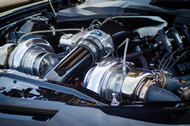What Is a Mass Air Flow (MAF) Sensor and How Does It Work?
8th Jul 2021

Sensors are commonly found in cars, trucks and SUVs. Regardless of what type of vehicle you drive, it probably has an array of sensors. While you may already know some of them, the Mass Air Flow (MAF) sensor is an automotive sensor that often goes unnoticed. So, what is the MAF sensor, and how does it work?
What Is the MAF Sensor?
The MAF sensor is a device that's responsible for measuring how much air enters the engine's combustion chamber. It's found in all fuel-injection vehicles. If your vehicle has a fuel-injection engine, it will likely have a MAF sensor. You can usually find the MAF sensor around the engine air filter and the intake manifold. It's a small electrically powered part that will measure how much air enters the engine's combustion chamber.
The purpose of the MAF sensor is to ensure that the engine's combustion chamber doesn't get too little or too much air. Automotive engines don't run strictly on gas; they require air as well. The combination of air and gas is what allows automotive engines to generate combustion. The MAF sensor simply checks to ensure that your engine is getting the appropriate amount of air.
How the MAF Sensor Works
There are different types of MAF sensors, but most of them work in the same way. The MAF sensor features two wires. One of these wires is connected to your vehicle's electrical system. With your vehicle running, electricity will flow through this wire while simultaneously heating up the wire. As air travels through the air filter, it will pass over this powered and heated wire, thus cooling the wire. The MAF sensor will then measure the temperature difference between the two wires to determine how much air is entering your engine's combustion chamber.
Signs of a Bad MAF Sensor
If your vehicle has a bad MAF sensor, you may notice one or more problems. A rich- or lean-running engine, for instance, can occur with a bad MAF sensor. Engines run rich if they have too much gas and not enough air in the combustion chamber. Engines run lean, on the other hand, if they have too much air and not enough gas.
With a bad MAF sensor, your engine may not have the correct ratio of gas to air, resulting in a rich- or lean-running engine. A bad MAF sensor can cause rough idling as well. If your vehicle shakes while idling at red lights or other places, a bad MAF sensor could be to blame.

